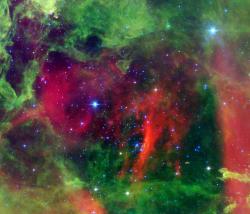 If you’re a newly forming star system, there’s no better place to be than a stellar nursery. All those raw elements make the perfect building blocks of stars and planets. The problem is that super hot giant stars can release great torrents of radiation, blasting away newly forming planets.
If you’re a newly forming star system, there’s no better place to be than a stellar nursery. All those raw elements make the perfect building blocks of stars and planets. The problem is that super hot giant stars can release great torrents of radiation, blasting away newly forming planets.
Continue reading “Cooler Stars Need to Keep Out of the Danger Zone”
Matter Should Dominate the Universe Forever
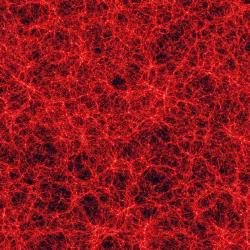 Thanks to Einstein, we know that matter and energy are just different versions of one another. E=mc2 tells you how much energy you’d get if you converted mass into energy. Don’t try, it’s hard. Physicists were concerned that all matter in the Universe would eventually decay into radiation after trillions and trillions of years of time.
Thanks to Einstein, we know that matter and energy are just different versions of one another. E=mc2 tells you how much energy you’d get if you converted mass into energy. Don’t try, it’s hard. Physicists were concerned that all matter in the Universe would eventually decay into radiation after trillions and trillions of years of time.
Continue reading “Matter Should Dominate the Universe Forever”
Hubble’s Detailed Photograph of the Carina Nebula
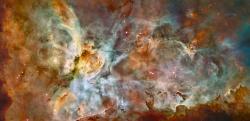 It’s hard to believe, but the Hubble Space Telescope has been churning out discovery after discovery for 17 years now. To celebrate the anniversary, NASA and ESA released a high-resolution image taken by Hubble of the Carina Nebula. And what a photograph!
It’s hard to believe, but the Hubble Space Telescope has been churning out discovery after discovery for 17 years now. To celebrate the anniversary, NASA and ESA released a high-resolution image taken by Hubble of the Carina Nebula. And what a photograph!
Continue reading “Hubble’s Detailed Photograph of the Carina Nebula”
Observatories Get the Jump on Gamma Ray Bursts
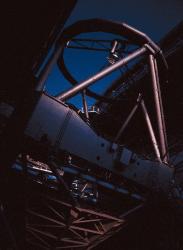 Even though gamma ray bursts are the most powerful known explosions in the Universe, you’ve got to move quickly if you want to capture useful science from them. A new press release from the European Southern Observatory goes into detail about how they work quickly to catch a burst’s fading light.
Even though gamma ray bursts are the most powerful known explosions in the Universe, you’ve got to move quickly if you want to capture useful science from them. A new press release from the European Southern Observatory goes into detail about how they work quickly to catch a burst’s fading light.
Continue reading “Observatories Get the Jump on Gamma Ray Bursts”
Supersonic “Bullets” of Gas Ejected from the Orion Nebula
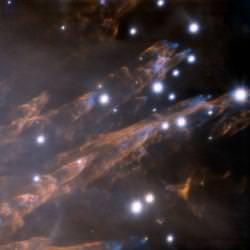 This beautiful photograph shows a small portion of the star-forming Orion Nebula. The strange, wake-like structures are supersonic “bullets” of gas ejected from the nebula. What actually caused these ejections is still unknown, but astronomers think there was a recent violent event that fired them out.
This beautiful photograph shows a small portion of the star-forming Orion Nebula. The strange, wake-like structures are supersonic “bullets” of gas ejected from the nebula. What actually caused these ejections is still unknown, but astronomers think there was a recent violent event that fired them out.
Continue reading “Supersonic “Bullets” of Gas Ejected from the Orion Nebula”
Jupiter As Seen From Saturn
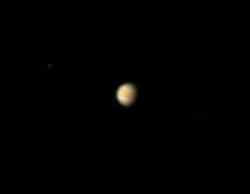 It’s not a great picture of Jupiter, but that’s not the point. The point is that the photograph was taken by NASA’s Cassini spacecraft, which is currently orbiting Saturn.
It’s not a great picture of Jupiter, but that’s not the point. The point is that the photograph was taken by NASA’s Cassini spacecraft, which is currently orbiting Saturn.
Continue reading “Jupiter As Seen From Saturn”
A Very Long Lasting Gamma Ray Burst
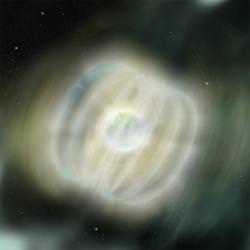 Gamma ray bursts are some of the most energetic events in the Universe. Even more amazing is just how quickly it all unfolds. One moment, everything’s quiet. A moment later, there’s a tremendous explosion that we can see from billions of light years away. And just seconds later, it’s gone again – the afterglow will be around for a few days, but that’s it. Astronomers and spacecraft have only a few seconds to a few minutes to find the explosion and study it before it fades away.
Gamma ray bursts are some of the most energetic events in the Universe. Even more amazing is just how quickly it all unfolds. One moment, everything’s quiet. A moment later, there’s a tremendous explosion that we can see from billions of light years away. And just seconds later, it’s gone again – the afterglow will be around for a few days, but that’s it. Astronomers and spacecraft have only a few seconds to a few minutes to find the explosion and study it before it fades away.
Continue reading “A Very Long Lasting Gamma Ray Burst”
New Globular Cluster Discovered
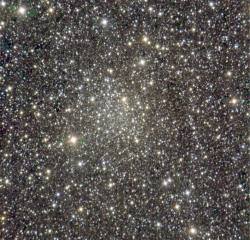 Globular star clusters are gigantic collections of stars formed at the same time, and held together by their mutual gravity. Amazingly, they’re some of the oldest objects in the Universe – some are more than 10 billion years old. More than 150 globular clusters have been discovered in the Milky Way by astronomers. And now you can add one more to that list.
Globular star clusters are gigantic collections of stars formed at the same time, and held together by their mutual gravity. Amazingly, they’re some of the oldest objects in the Universe – some are more than 10 billion years old. More than 150 globular clusters have been discovered in the Milky Way by astronomers. And now you can add one more to that list.
Continue reading “New Globular Cluster Discovered”
Podcast: The Story of Galaxy Evolution
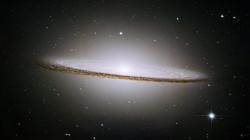 Our Milky Way is a complex and majestic barred spiral galaxy. But 13.7 billion years ago it began, like all galaxies, from the elementary particles formed in the Big Bang. How did our galaxy grow from nothing to the hundreds of billions of stars we see today?
Our Milky Way is a complex and majestic barred spiral galaxy. But 13.7 billion years ago it began, like all galaxies, from the elementary particles formed in the Big Bang. How did our galaxy grow from nothing to the hundreds of billions of stars we see today?
Continue reading “Podcast: The Story of Galaxy Evolution”
A Baby Picture of the Sun
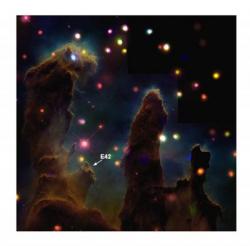 Obviously there’s no way to see what our Sun looked like when it was still forming billions of years ago, but you can do the next best thing. Find a newly forming star with very similar mass and chemical constituents, and see how it’s starting out.
Obviously there’s no way to see what our Sun looked like when it was still forming billions of years ago, but you can do the next best thing. Find a newly forming star with very similar mass and chemical constituents, and see how it’s starting out.
Continue reading “A Baby Picture of the Sun”
